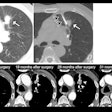Dear AuntMinnie Member,
Radiologists have been looking for ways to cut both CT radiation dose and variation in dose between different scanners. Today in our CT Community, we offer the story of a Pennsylvania hospital that took three simple steps to reducing both.
Researchers at Einstein Healthcare Network in Philadelphia were able to reduce variability in dose by as much as 69% depending on clinical application, according to data they presented at RSNA 2017. Their strategy involved three major steps, the most important of which was establishing a dose optimization committee to develop scanning protocols and ensure they were used throughout the health system.
Learn about the other steps they took by clicking here, or visit our CT Community at ct.auntminnie.com.
Why is the job market improving?
After several tough years, the job market for radiologists appears to be improving. Job opportunities are on the rise, and employers are even having difficulty filling open positions, according to Daniel Corbett of recruiting firm Radiology Business Solutions.
What's behind the change? Mr. Corbett believes that shifting demographics are beginning to work in favor of radiologists. The aging baby boomer generation is requiring more medical care, while at the same time, boomer radiologists are starting to retire.
Learn more of his thoughts by clicking here, or visit our Imaging Leaders Community at leaders.auntminnie.com.
DBT finds smaller cancers
Finally, in a follow-up article on research presented at RSNA 2017, researchers from Yale University found that when digital breast tomosynthesis (DBT) was used for breast screening, it found smaller cancers that hadn't spread as much, compared with screening with standard 2D mammography. Click here for the article, or visit our Women's Imaging Community at women.auntminnie.com.



















